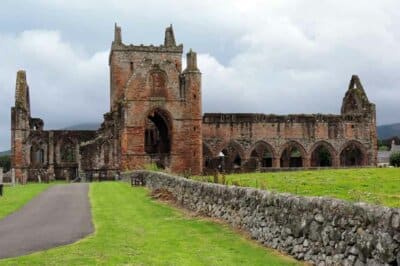Sweetheart Abbey, near Dumfries, was founded by the remarkable Lady Dervorguilla in 1273 in memory of her husband John Balliol.
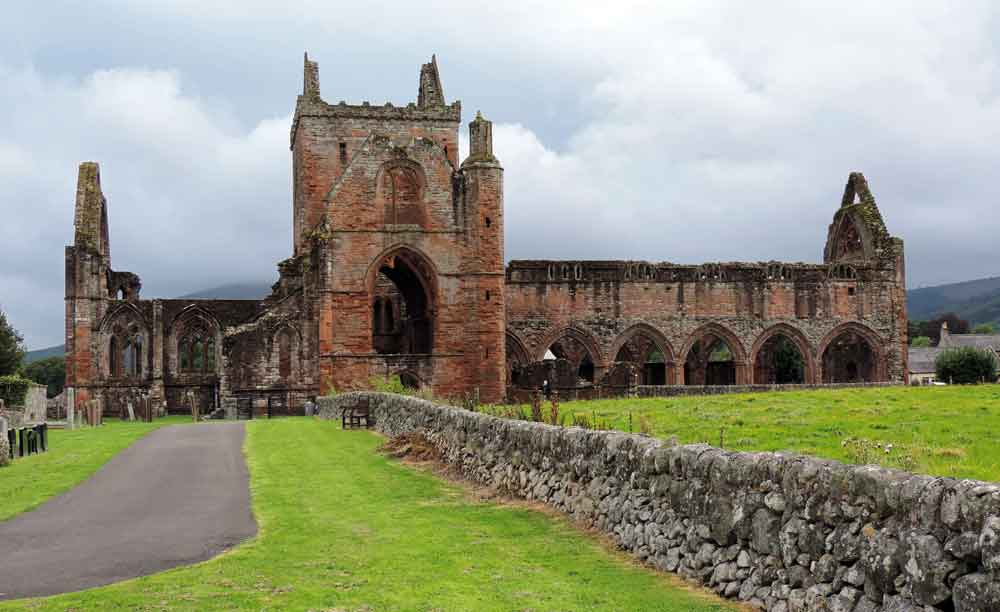
The history of Sweetheart Abbey
Sweetheart, Dulce Cor in Latin, the last Cistercian abbey to be founded in Scotland, lies around seven miles from Dumfries.
“Not far distant from the ruins of Caerlaverock Castle on the opposite side of the River Nith, are seen peeping through the trees, the gray ruins – the mouldering, yet still beautiful arches, columns and walls of Sweetheart Abbey – backed by the lofty Criffel whose mountain shadows impart solemnity and awe to these crumbling relics of monastic grandeur.”
It’s a wonderfully romantic and evocative picture of Sweetheart Abbey, penned by a 19th century writer who perhaps understood the touching story of Dervorguilla, the lady of Galloway.
Lady Dervorguilla and SWEETHEART ABBEY
Lady Dervorguilla was born c. 1210, the daughter of Alan, Lord of Galloway and Margaret of Huntingdon.
She was a woman who could, on her mother’s side, claim royal descent from Saint Margaret of Scotland (mother of David I).
Her distinctive name was the Latinisation of the Gaelic (Derbhforgaill) which may have come from an Irish ancestor in the Galloway line.
Chronicler Walter Bower, writing many years after the event, argued that Dervorguilla was illegitimate because the dispensation requested for her parents’ marriage (they were cousins) was not awarded because the messenger carrying the request had died on the way to Rome. How different would her life have been should her illegitimacy have been established?
Marriage to John de Balliol
The Chronicles of
Melrose records that in 1233, Alan of Galloway gave his daughter to John de Balliol (I) in marriage. Together the couple had at least eight children. The eldest son, also John Balliol (II), was a future king of Scotland.
Frustratingly, information about her early life is scarce. It’s only after her marriage that we learn more about her.
The death of her father in 1234 brought substantial wealth to Dervorguilla and her husband, with further inheritances adding considerably to their fortune.
Writer Geoffrey Stell said that while figures are lacking, her Scottish lands were probably worth around £470 per annum, a considerable amount in the 13th century.
Referring to her wealth and how it was spent, Andrew Wyntoun, historian and chronicler, credits her, in a lengthy panegyric, with building friaries in Wigtown and Dumfries. He wrote, “How Devorguil that Lady Spendyt hyr Tresoure Devotly.”
On a note of caution, G. P. Snell said, “Her reputation for pious munificence has probably gone beyond authenticated record.”
Henry III of England
Balliol (I), a loyal supporter of King Henry III of England, came from a distinguished family with vast estates in the north of England. It’s probable that his family, originally de Bailleul of Picardy, France arrived in England with the Conqueror in 1066.
Following the death of King Alexander III in March 1286 he was succeeded by the infant Margaret, Maid of Norway who in September 1290 died on her way to Scotland. Her death left no obvious heir to the throne.
In the succession crisis that followed, Edward I of England saw the opportunity to flex his muscles and exploit the situation.
Ultimately the choice of who would take the Scottish throne became a contest between Dervorguilla’s son John Balliol (II) and Robert Bruce, grandfather of Robert the Bruce who fought at Bannockburn.
Edward, asked to adjudicate, chose Balliol (II), adjudged to have the stronger claim.
Balliol was forced to swear fealty to the English king as his superior and overlord. He was crowned king in 1292 and spent almost four years trying to rule effectively in very difficult political circumstances.
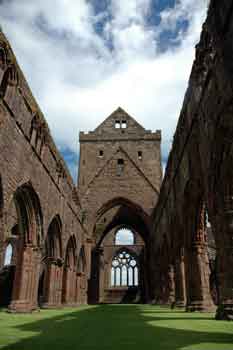
Furious at the Scots signing the Auld Alliance, a mutual defence treaty with France, Edward I sent a large army north.
Laying much of the country to waste, he defeated the Scots at the Battle of Dunbar in March 1296.
The Ragman Roll
Over 1,900 of Scotland’s nobles were forced to pay homage to Edward and their names and seals were attached to perhaps the most infamous document in Scottish history – the Ragman Roll.
Included on that list was Abbot John of Sweetheart Abbey. His seal is still preserved in the Public Record Office in London.
‘Toom Tabard’
Within months of Dunbar, Balliol (II) was forced to abdicate. The removal of heraldic insignia from his coat as part of his submission earned him the epithet ‘Toom Tabard’ (empty coat).
For a time he languished in the tower of London before being allowed to return to his estates in France where he died in 1313. With Balliol gone, the long and bloody Scottish Wars of Independence stretched ahead.
Interestingly there are now a number of historians who argue that both John Balliol (II) and his son Edward (r. 1332-56) were misjudged and should properly be regarded, not as politically weak and unsuccessful monarchs, but as influential Anglo-Scottish lords.
Respected scholar Richard Oram argued that Balliol (II) was, “not the bumbling mediocrity” he was portrayed as. Professor Archie Duncan said that he was, “a man trapped by circumstances beyond his control.”
Oxford University
The Balliol name is of course forever linked to Balliol College, the oldest college in the English-speaking world and now part of the prestigious Oxford University.
The reasons behind John Balliol’s (I) decision to establish the college in 1263 is today a matter of some debate. Was it a matter of penance or was he influenced by Dervorguilla?
Oxford University says simply that Balliol (I) was ‘prompted’ by the Bishop of Durham to carry out an act of charity. “This he did by renting a house in Oxford and maintaining in it some poor students.”
The Chronicle of Melrose states that Balliol (I) was a, “lover of Scholars and out of his love towards God he built a house at Oxford.”
Certainly, Dervorguilla is considered a co-founder of the college having provided it with a permanent capital endowment, statutes and its first seal which the college still has.
Today the college offers several scholarships in her name.
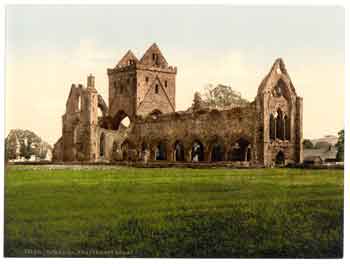
For the determined researcher, Balliol College Archives and Manuscripts provide some excellent early resources relating to Dervorguilla and the college foundation.
Kylie Murray, a research fellow at Oxford University, writing in Balliol College’s Floreat Domus, covers an area she considers largely overlooked in the study of Scotland’s cultural and literary history.
That is the four (or more) of the 12 surviving manuscripts of the period with a Scottish provenance that are connected with Dervorguilla, her family and Sweetheart Abbey. Some of those identified come from the medieval diocese of Glasgow.
There is some excited speculation over one particular manuscript, now in the Bodleian Library, – the 12th century treatises of Jerome followed by Hugh of St Victor on the sacraments.
The flyleaf has a statement of ownership – “Liber domine dervorgoyl de bayll” (Book of Lady Dervorguilla de Balliol). While Murray acknowledges that they cannot determine conclusively who penned the inscription she said, “It is not impossible that we have her autograph.”
Another manuscript, with Galloway and Dervorguilla provenance is Gregory the Great’s Dialogues on the miracles of St Peter, now housed in Edinburgh University Library.
What makes the document particularly interesting is the curse that warns anybody tempted to steal the book, “Let he would steal this, be anathema (cursed).
Related articles
Richard Oram, reflecting on the content at Sweetheart’s monastic library acknowledged that some of it came from Dervorguilla’s collection of devotional texts.
It points, he said, to a, “more rounded religiosity, providing an intriguing insight on the personal beliefs of the late 13th century nobility.”
Sweetheart Breviary
Of course, manuscripts connected to the abbey are rare and any new ‘finds’ create some excitement.
Consequently, the arrival, in February 2016, of the Sweetheart Breviary at the National Library in Edinburgh has sparked considerable interest.
The Breviary, written between 1300 and 1350 from Sweetheart Abbey is an outstanding example of a medieval religious manuscript written and used in Scotland.
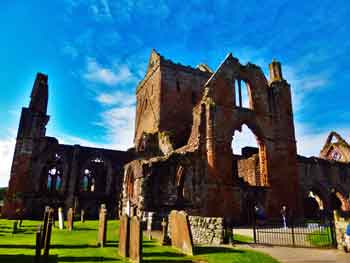
Its 200 velum pages, in surprisingly good condition, contain the text of monastic prayers used in medieval Scotland
Prior to its arrival in Edinburgh, the Breviary had been missing for three centuries before turning up at auction in Vienna, Austria.
When John Balliol (I) died in 1268 his grieving widow had his heart embalmed and put in an ivory casket which she carried with her at all times.
His body was then taken to Barnard Castle, near Durham in the north of England, to be buried.
Dundrennan Abbey
Sweetheart Abbey was the daughter house of Dundrennan Abbey, a religious house that David I, in collaboration with Fergus of Galloway, founded in 1142.
Although it was the final resting place of Dervorguilla’s father, Alan, Lord of Galloway, it’s perhaps better remembered as the place where Mary Queen of Scots spent her last night in Scotland in 1568 before going into exile in England.
Death of Dervorguilla
The monks of Dundrennan worked quickly to build the daughter house although some parts of the building remained unfinished when Dervorguilla died in the January of 1290. She was laid to rest, still clutching her husband’s heart, in front of the abbey church’s high altar.
Despite the Cistercian dedication to an austere lifestyle, the abbey had some nice if unexpected architectural flourishes. These include some fine stone tracery in the presbytery windows, the unusual window above the south transept and the splendid west front.
Louis XIV of France
Over the years there have been a number of archaeological discoveries at the site, although quite small, they are exciting nonetheless.
In 1854, some silver coins were unearthed, dating to the reigns of Charles I and II and Louis XIV of France.
They were found in the spot where it’s thought the monks received payment of their tithes. Also found were some Dark Age artefacts including a few Irish beads dating to the 6th – 7th century.
By 1300, Edward was back in Scotland staying at Sweetheart Abbey while campaigning in Galloway.
Eight years later the abbot petitioned the king and council for compensation of £5,000, an enormous sum in the 13th century. His petition demanded recompense for…
“the burning of their granges and destruction of their goods”.
Abbot Sweetheart Abbey
Unsurprisingly no money was forthcoming. A claim was also made for the value of eight and a half bags of good teased wool taken for the late king’s use. We can only guess the outcome of that.
Towards the end of the 14th century Archibald ‘the Grim’ Douglas, the 3rd Earl of Douglas and Lord of Galloway became patron of Sweetheart Abbey.
As the son of Sir James Douglas who fought with Robert the Bruce he was one of the most powerful men in southern Scotland and his grants made in 1381 and 1385 allowed rebuilding and regeneration of the abbey precinct following the Wars of Independence.
Sweetheart Abbey then fades from history until the emergence of John Knox and the Scottish Reformation which it survived relatively unscathed.
Lord Maxwell a local landowner must take much of the credit for that, refusing instructions from the Lords of the Congregation to destroy the buildings.
Following the Reformation, the abbot John Brown resigned and Gilbert Brown became commendator and titular abbot and continued to hold Catholic mass.
For this, he was exiled to France only to return once again to Sweetheart Abbey. He was again exiled to France but returned two years later.
In 1608 he was still holding mass and was for the final time dispatched to France where he died in 1612.
It’s thought that his determination to continue ‘traditional’ worship meant that Sweetheart was the last monastery in Scotland to continue to hold Catholic mass after its official abolition in 1560.
The abbey refectory was used as a parish church until 1731 when it was pulled down and replaced with a church on another part of the site.
Like many former Catholic places of worship, after the Reformation, the buildings became a convenient source of stone for local residents to use in their own building work.
Thankfully in 1779 what remained of the abbey was protected from further destruction by the actions of a group of concerned local people.
William Paterson founder of the Bank of England and one of the early supporters of the Darien Scheme
Among those who lie at Sweetheart Abbey is William Paterson who died in January 1719.
Although his grave is unmarked a small commemorative plaque tells us of his place in history. It says “A founder of the Bank of England (1694) and originator of the Darien Scheme (1698). Paterson was born at Skipmyre Farm, Tinwald, Lochmaben [about 17 miles from the abbey].”
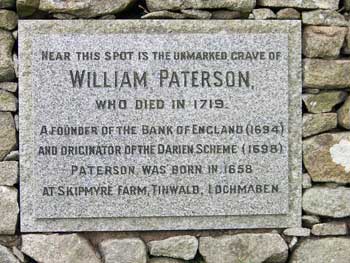
It’s the briefest of reminders of his role in the Darien Scheme which ultimately ended in financial disaster, its catastrophic failure pushing his country closer to Union with England.
- The University of Glasgow Spencer Collection has some fascinating additional information about the Darien Scheme. i
In the eyes of many people, the abbey is not just about its physical presence, however beautiful its red sandstone walls are, it’s about the memory of Dervorguilla de Balliol, lady of Galloway.
But, “there is no stone left to mark the spot; no ruined shrine, no broken carving, no time-worn words. There is nothing but the ruin, to tell of her who built the abbey, and whose body sleeps there.”
Historic Environment Scotland – Sweetheart Abbey Visitor Information
For information on opening hours, cost of entry and other tips to help you plan your visit, go to the official HES website.
